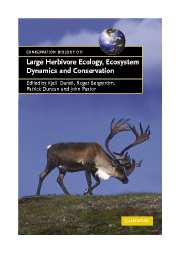Book contents
- Frontmatter
- Contents
- List of contributors
- Preface
- Introduction
- 1 Large herbivores across biomes
- 2 Living in a seasonal environment
- 3 Linking functional responses and foraging behaviour to population dynamics
- 4 Impacts of large herbivores on plant community structure and dynamics
- 5 Long‐term effects of herbivory on plant diversity and functional types in arid ecosystems
- 6 The influence of large herbivores on tree recruitment and forest dynamics
- 7 Large herbivores: missing partners of western European light‐demanding tree and shrub species?
- 8 Frugivory in large mammalian herbivores
- 9 Large herbivores as sources of disturbance in ecosystems
- 10 The roles of large herbivores in ecosystem nutrient cycles
- 11 Large herbivores in heterogeneous grassland ecosystems
- 12 Modelling of large herbivore–vegetation interactions in a landscape context
- 13 Effects of large herbivores on other fauna
- 14 The future role of large carnivores in terrestrial trophic interactions: the northern temperate view
- 15 Restoring the functions of grazed ecosystems
- 16 Themes and future directions in herbivore‐ecosystem interactions and conservation
- Index
- References
8 - Frugivory in large mammalian herbivores
Published online by Cambridge University Press: 16 November 2009
- Frontmatter
- Contents
- List of contributors
- Preface
- Introduction
- 1 Large herbivores across biomes
- 2 Living in a seasonal environment
- 3 Linking functional responses and foraging behaviour to population dynamics
- 4 Impacts of large herbivores on plant community structure and dynamics
- 5 Long‐term effects of herbivory on plant diversity and functional types in arid ecosystems
- 6 The influence of large herbivores on tree recruitment and forest dynamics
- 7 Large herbivores: missing partners of western European light‐demanding tree and shrub species?
- 8 Frugivory in large mammalian herbivores
- 9 Large herbivores as sources of disturbance in ecosystems
- 10 The roles of large herbivores in ecosystem nutrient cycles
- 11 Large herbivores in heterogeneous grassland ecosystems
- 12 Modelling of large herbivore–vegetation interactions in a landscape context
- 13 Effects of large herbivores on other fauna
- 14 The future role of large carnivores in terrestrial trophic interactions: the northern temperate view
- 15 Restoring the functions of grazed ecosystems
- 16 Themes and future directions in herbivore‐ecosystem interactions and conservation
- Index
- References
Summary
INTRODUCTION
Body size and complexity of digestive systems are key factors in the herbivore ecology of mammals (Langer 1987), and much attention has been devoted to herbivory in browsing and grazing forms and how this relates to conservation (Sinclair & Arcese 1995, Owen‐Smith 2002). However, frugivory, or fruit feeding, is equally important in the ecology of mammalian herbivores and the conservation of biodiversity (Bodmer 1990, Andresen 2000, Levey et al. 2002). This chapter looks at frugivory in large mammalian herbivores. It focuses on the tropical regions, but we must stress that frugivory is equally important in temperate habitats. The chapter examines: (1) the relationships between frugivores and the evolution of browsing and grazing herbivory; (2) the ecology of frugivory in relation to seed dispersal and seed predation; and (3) two case studies of frugivory, one in the Negev desert and the other in Amazonia. The case studies show the importance of frugivory in the ecology of large herbivores, and the links between frugivory and conservation.
Successful biological conservation requires an understanding of the ecology of species and their interactions with human resource use (Freese 1997). Frugivory in large herbivores exemplifies these relations and the need for studying ecological interactions to understand the application of successful conservation (Levey et al. 2002). For example, the bush meat crisis in tropical forests is currently one of the most important conservation issues that must be addressed (Robinson & Bennett 2000).
- Type
- Chapter
- Information
- Large Herbivore Ecology, Ecosystem Dynamics and Conservation , pp. 232 - 260Publisher: Cambridge University PressPrint publication year: 2006
References
- 22
- Cited by

